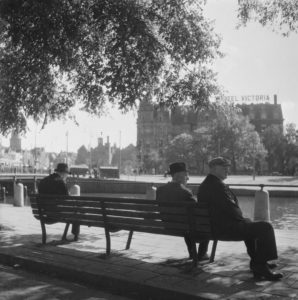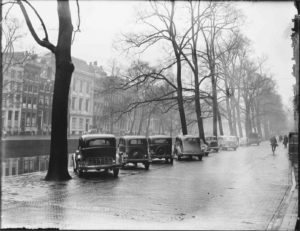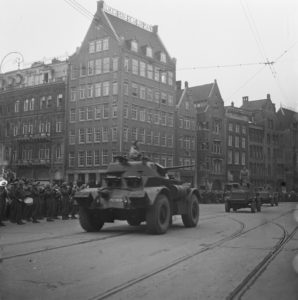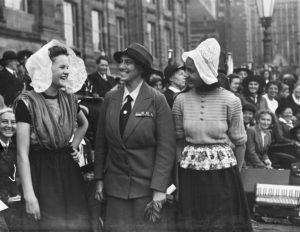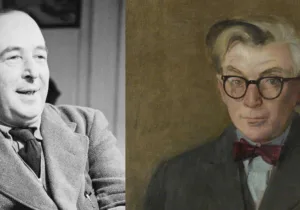“Letter from Holland,” by L.H. Ruitenberg
August 5, 1946
While North Americans, on being informed of the church situation in Holland, are not in the least surprised about the great number of denominations here, the West Europeans, brought up in a church tradition, consider this diversity a painful and embarrassing symptom. The cause of this difference in appreciation is that many of our churches are the result of secession and schisms. Originally the Roman Catholic Church prevailed throughout the country; since the Reformation more and more smaller churches were formed, mostly after serious conflicts with the mother church. The process seemed to be endless. Meanwhile the authority of the churches dwindled and secularism grew stronger. Even within the churches an estrangement from church-life became apparent, showing itself both by a loosening of the ties among the members of one community and by lack of solidarity among the several communities belonging to one church.
The last census, held in 1930, shows that Holland can no longer be called a Protestant nation. By the side of 36 per cent Roman Catholics, 14 per cent of the population registered as belonging to no denomination whatever. In the remaining Protestant Sector, 34 per cent were found to belong to the Netherland Reformed Church (Nederl. Hervormde Kerk), dating from the time of the Reformation; 8 per cent belonging to the so-called “Gereformeerde” Churches (Fundamentalist dissenting Church), and the remaining 8 per cent belonged to the older churches (Mennonists, Lutheran and Remonstrant) and the younger ones (Christian Reformed, Restored Apostolic, Free Evangelist and Baptist).
Such was the state of things, when on the 10th of May, 1940, the fury of the war began to rage in Holland.
It is not yet possible to register all the changes in the Churches caused by the war; but I shall try to describe a few tendencies.
My starting point for this is the Netherlands Reformed Church. It was this Church that came forth from the struggle for freedom in the Low Countries in the 16th century as the Established Church. Although the existence of other churches was acquiesced in, the Established Church continued to take the lead in spiritual affairs up to the French Revolution. Only members of this Church could fill official posts, and the authorities exerted great influence on Church affairs. Within it there was a broad stream of orthodoxy, sometimes divided by internal quarrels; and also a smaller humanist current, which, through its relation to the Government, was rather influential.
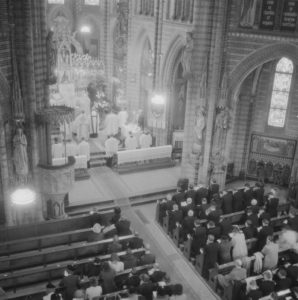
After the French Revolution this situation underwent a drastic change. After a period of seventeen years’ French domination—which seems an idyll now after five years of German occupation—the old situation could not be restored. The ideas of the French Revolution had sunk in. This meant separation of Church from State, though the after effects of the established church relations of the 17th century retained their influence. It is due to this influence that King William I, although he was not entitled to do this according to law, had a relation to the late Established Church, defined by himself and not the church tradition. He was a typical example of the enlightened despot of the beginning of the 19th century. The ecclesiastical law became as it were a reflection of the Polity, which he desired. This resulted in small governmental bodies, little influence of lower organs, no influence at all of the members, a rigid separation between the material management of the Church and spiritual guidance, and no possibility of testing the tenets of the church or of exercising ecclesiastical discipline.
In the course of the 19th century, when liberalism gained ground, much was changed in this ecclesiastical law. It became more democratic. But the structure remained. The consequence was that though the Church members were united in one organization, all but unlimited spiritual freedom prevailed. This freedom, however, mostly remained—owing to the typical Dutch moderation—within the limits of what may be considered universal Christian faith.
A reaction to this course of affairs was only to be expected. Fundamentalist groups desired two things: a change of the church order and a possibility of bringing into force the doctrine of the Church as it had been defined in the first—and last—Reformed Council of Dordrecht in 1618. Throughout the 19th century a fight was carried on against the Church order of King William I. It appeared to be practicable for those groups that desired a freerer biblical preaching. Serious secessions were the consequence. The great statesman and church leader, Dr. Abraham Kuyper, left the Church with his followers as “dissenters,” and formed in 1892 with some groups that had seceded earlier as a reformed denomination on a basis of a rigid literal interpretation of the Bible.
Yet a great part of the orthodox members remained faithful to the old Dutch Reformed Church. They considered Kuyper’s action premature and wished to abide God’s time. Meanwhile “modern life” expanded. A strong socialist trend, for the greater part standing outside the Churches and at first even opposed to them, gave new ideas to thousands of people. The enlightened middle-classes, it is true, whose outlook was moderately rationalistic and liberal remained in the Church, but spiritually they were remote from it, while the younger ones cut the tie that bound them to it. This double process: secession, which caused the isolation of the Christian part of the people, and growing secularism, the apostates only showing their heritage by their maintenance of moral values, reduced the Reformed Church to a state of decline. This she tried to overcome by deliberate conservatism, thus consolidating the relation of the different trends and leaving the necessary missionary work—in Holland itself as well as in the West and East-Indies—to private associations of Christians.
The church derived its significance therefore in the life of the people from the past, not from the future.
****
The consequences of the German occupation have been great for the Churches. The occupation broke down all organs of spiritual life or attenuated them. Political parties were forbidden, the youth movement destroyed, the trade unions forced in one association and put under National Socialist guidance. The wireless—hitherto in the hands of five separate broadcasting companies—became a German propaganda institution. This occupation pressure stopped at the border of the Church, not from reverence, but for opportunist considerations. The Nazis wanted to give the appearance of protecting European culture. We are in honesty bound to declare that whatever inhuman cruelties were perpetrated (80 per cent of the Dutch Jewry was murdered), that formally no Church persecution took place. It is true that many clergymen, who were moved by their evangelic faith to attack National Socialism, were arrested and met their death. The bold protests of the Churches were entirely ignored if they had not been intercepted beforehand; the spiritual ground required by the Church to live, was restricted more and more; but the Church organization as such was not touched by the occupier.
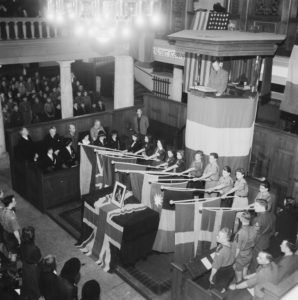
That is how the Church became the only possibility of giving the people a voice. This gave it a heavy responsibility, more particularly the Netherlands Reformed Church, which, owing to its size and tradition, had so many advantages over all other Churches. This situation gave an impulse to a remarkable change in this Church.
Its leaders understood that it could not accomplish its task without an inner change. They investigated the causes that prevented it from really being a Church. Before the war a change in the regulations in order to realize the confessions of faith had been a bone of contention. Now the leaders said: However important these things may be, it is more important that a new spiritual attitude be taken up, which teaches man to live again according to the Bible and the Gospel, and devotes itself with great compassion to the spiritual and material sorrows of the people.
Professor H. Kraemer, since 1938 Professor in Holland’s oldest University, Leyden, and before that one of the directing spirits of missionary strategy, is the Church leader who formulated the clearest policy; through his long stay in the Far East he had learned to see the problems in another perspective and understood that it was most important in the process of re-Christianization of Europe to reform the old Church into a missionary Church.
It is the method employed in missionary work, which, applied to Dutch relations, has effected a change in the Reformed Church. The rules do not come first but an attitude of mind. Decisions should not be made before deliberations at the round table have been undertaken together with all who are separated by theological and social differences. The conviction is fostered that working for the Church is more important than anything else. An understanding of each other’s attitude of mind may not be reached during discussion, but joint work at practical tasks—deaconry, youth movements, etc.—may enable us to penetrate to the kernel of our difficulties. This method, called “Community Reconstruction,” was generally accepted, very reluctantly, it is true, in extremely left and extremely right circles; so much so in some cases that one can hardly speak of acceptance. But the most responsible Church leaders came together, concurred in new plans, and took part in searching discussions. The common feeling was that all this was done “in obedience to the Holy Scripture and on the ground of the Church Confession.”
Results have been remarkable; what had not succeeded in a century was now unanimously accepted, viz., the abolition of some central parts of the Church order and the acceptance of a preliminary working-order which explicitly charged a committee to prepare a new church order. This working-order gave all power to the “General Synod,” which was chosen directly by the assemblies of the so-called “Classes” (organization of several parishes) and could be considered to be the voice of the Church.
This has indeed assuaged the struggle between the different factions. Some of the denominational rigidity has been broken through, which has had the result that much work in the different communities could be tackled in a new way.
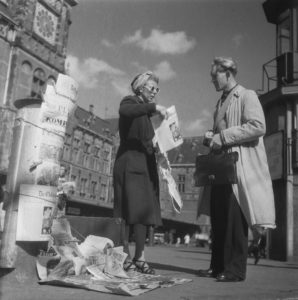
However, all this is still in its initial stage, for the war, during which all this was attained, created a peculiar atmosphere. The communications through press and personal visits were bad and got worse and worse as the understanding got better. The parishioners had to put an immense trust in their leaders. And this they did. They understood that in this abnormal time the masses could hardly be consulted. Besides the consciousness of standing in one front against the common enemy, the Germans, created a feeling of unity which had not been reached by deliberate thought and discussion. The leaders understood this very well and have done what they could to let the community and their officiating clergymen have their share in the work. Many difficult journeys were made and conferences held, costing a good deal of time. They knew they had to strike the iron while it was hot.
****
Now that we have been free for a year, we can affirm that the spirit of renewal, the spirit of deliberate activity, and active deliberation has leavened many minds. The organization of the Church is renewed. It has not fallen back into the old party division. But peace has also brought the unavoidable and necessary reaction. It is now important to put into practice the ideas conceived and bear the fruits of the new attitude of mind, resting on the Bible.
This appears to be difficult on two points. Although nobody desires a return to the old situation, in which entirely estranged parties had to live as each other’s enemies in one Church, there exists a fundamentalist current that does not object to general discussions, but disapproves of a cooperative work. The “General Synod,” however, desires both cooperation and theological discussion. The Church must find a new confession of faith by a corporate life of both orthodox and liberal members.
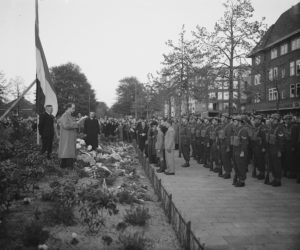
The second difficulty relates to politics. Before 1940 there existed Christian political parties, Christian associations exercising authority over schools, trade unions, and wireless. They united orthodox Christians into an organization using its power in these domains. By doing so they saved many from estrangement from the Church, but on the other hand the Church fell short in its missionary task. Where Christianity has become a political party, it has become an obstacle in the recruiting of those that stand “outside.” In this respect it fails in its responsibility towards the whole people.
Hence already during the occupation many a Church leader had come to the conclusion that the Church should make no connection with such Christian organizations of power, and that it should be accepted and even applauded when Christians joined non-Christian organizations, a thing that hardly ever happened before the war. After the war this desire was realized. A comparatively great number of clergymen joined the recently formed Party of Labor, arisen from a fusion of the old Socialist Party with the middle-class radicals and a group of Christian Democrats with a strong Socialist tendency. This group was joined by many Christians, who before had been members of Christian political organizations, but who desired together with non-Christians to fight for a planned economy, for the liquidation of colonial relations and democratic Socialism.
However, this is no church matter. The synod has declared explicitly that the Church is not bound to any political party. But, since formerly practically all orthodox Christians belonged to politically conservative organizations, this could not but mean that it was now considered quite acceptable if members of the same religious persuasion become each other’s political opponents.
The recent elections for the second Chamber have shown the “church people,” the average parishioners, to be conservative, for they did not follow the lead of many clergymen who openly declared themselves for the Party of Labor. The joint “Christian” political parties lost hardly any votes. The causes of this lie in the natural inertia of the “masses”— and “church people” are part of the “masses”—and in the inevitable lack of contact between leaders and congregations during the time of occupation when these ideas took shape.
We have written in detail of the Netherlands Reformed Church. Its history is of absorbing interest and to a certain extent symptomatic for what has happened to the whole people. Leaders want to go forward at full sail to a new order of things; but the masses, from lack of training, cling to the old slogans. From a standpoint of international politics it is horrifying that the desire to break the colonial tie is opposed fiercely by the orthodox Christians, politically organized, who have refused to follow either the policy of the present Government, or the advice of the Mission, and the declaration of the “General Synod.”
As to the other great churches we may say in brief that the “Gereformeerde” Churches are torn by quarrels about the significance of the sacrament of baptism; and that the Roman Catholic Church in the Netherlands is consolidating its power by combining cautious progressiveness in political and social matters with great activity in things spiritual and the consistent isolation of its members.
Lambertus Hendrik (Bart) Ruitenberg (1905 – 1992) was a Dutch clergyman and an editor of the religious-socialist magazine Tijd en Taak (Time and Task), a publication of the Woodbrookers, for which Ruitenberg served as chairman. From June 1968 to December 1970, he was also editor-in-chief of Hervormd Nederland (Reformed Netherlands). He belonged to a movement of Christian Socialists who joined the Labor Party (PvdA), where he was an active member of the Protestant-Christian Work Community.
